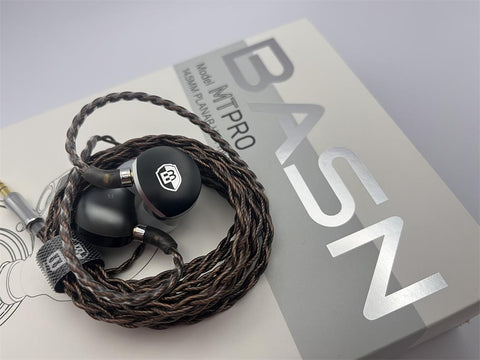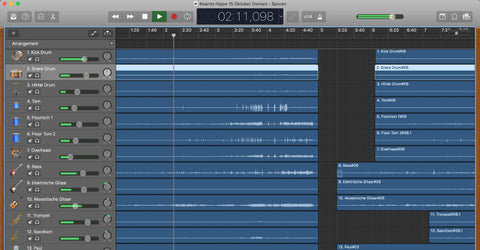IN-EAR MONITORS: FOR LIVE AND REHEARSAL USE?
Guest-blogger Niels is here to tell you why in-ear monitoring (IEM) isn’t only great for gigs, but rehearsals! Together with the other six members of his band, Niels decided to get in-ear monitors for live performances, but they soon found out that there are also various benefits to using the system in their rehearsal space: much less noise and the ability to actually hear what you’re working on.

NO MORE RINGING IN OUR EARS
As a regional band, we’re not expecting a national breakthrough anytime soon. We play our shows locally, either in small pubs or at larger festivals, and we basically never know whether our sound engineer for the gig is going to be an industry professional or a dabbler. Getting our own in-ear monitors has already proven its worth though, since we now have control over the mix we hear on stage, take less time sound-checking and any damage to our hearing is now prevented. We know from experience that there are sound technicians out there that won’t take your hearing into consideration, and simply turn the volume all the way up to make sure you’re able to hear the mix. Our in-ear system is also a space-saver on smaller stages: we’re no longer bothered by floor monitors, we have more room to move around, and piercing feedback has become a thing of the past.

CONNECTING IN-EAR MONITORS TO A MIXER
We consider our in-ear monitors to be an extra instrument. It’s a box on wheels fitted with a USB-MIDI controller and a Behringer X32 Producer digital mixer to which all of our other instruments are hooked up. The X32 offers 16 XLR inputs and six additional line inputs and outputs, and fortunately so, because the drums alone take up 7 channels. Each band member has his own Shure SE315 in-ear monitors and Fischer Amp Mini Body Pack XLR. The body-pack is connected to the XLR output of the mixer via an XLR cable, and thanks to a smartphone/iPad app, everyone is able to adjust their own settings wirelessly. Of course, any sonic preferences can also be manually dialed in on the Behringer, but the biggest advantage of the in-ears is that my personal settings can be saved and recalled at the next gig.
MAKING AND LISTENING TO RECORDINGS
Another advantage of working with this set-up is that rehearsals and gigs, or at least parts of them, can be recorded and listened back to. This way, we can see what needs to be worked and continue to improve ourselves and put down even better performances. With our system, we’re even able to make a multi-track recording of our shows or rehearsals, so we have an accurate record that we can analyse and improve on, and each of us can actually hear our own performance in detail.

MOBILITY
The downside of bodypacks that we use is that we’re limited in terms of on-stage mobility, so we’re definitely dreaming of getting a wireless in-ear system one day so we can move and dance around larger stages. Unfortunately, at a cost of £200 per person for a high-quality wireless IEM system, the price tag isn’t in our favour, so the decision to start out with cables wasn’t too difficult to make.
ONLY THE DRUMMER MAKES NOISE NOW
What’s also great is that we don’t have to worry about damaging each other’s ears anymore. We rehearse in an uninsulated basement and as you can imagine, rehearsing with amplifiers can quickly turn into a nightmare. The in-ear monitors provide more peace and quiet, it’s just the drummer now that’s loud!
THE DRAWBACK OF LIVE IN-EARS
While they’re brilliant, in-ear monitors also shut out any ambient sound, which can lead to awkward moments when combined with a technical error. Just like Adele, it once happened to us that the PA system went down while we continued to play and give it our all. Like her, we didn’t realise there was no music anymore because the in-ear monitors were still working. When Adele was told the PA system had gone down during her song, she said: “The sound went off? The PA f**king cut off? Well it didn’t cut off in my ears, I could hear myself.” It’s a rare occurrence, but something to keep in mind regardless! Another technical issue that may arise has to do with wireless signal interference, causing the in-ears to malfunction. Coincidentally, this is exactly what happened to Adele during her performance at the 2017 Grammy Awards.
VIBE
Lastly, there’s one more debate that in-ear monitors give way to, and it has to do with the vibe that the artist or band gives off. Some people feel like the use of in-ears takes away a sense of intimacy and negatively affects the connection between the performer(s) and their audience. That’s why some only use one of the in-ear monitors instead of both. As a band, we also sometimes miss that genuine rock-and-roll vibe, which is when we just want to feel and hear the raw power of our amps and speakers. All things considered, we’re going to stick with our opinion though: in-ear monitors take performances to the next level.
Refer link: https://www.bax-shop.co.uk/blog/pa/in-ear-monitors-for-live-and-rehearsal-use/
